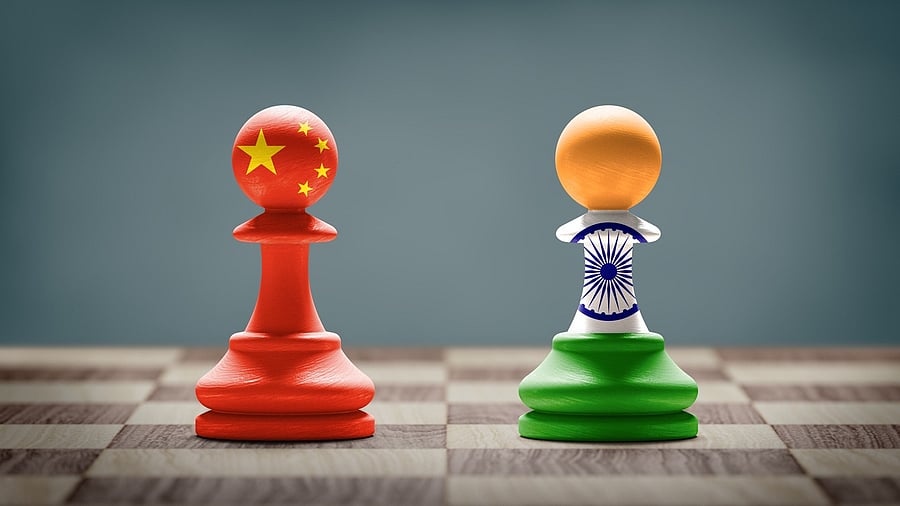
Representative image of India and China.
Credit: iStock Photo
At a time when India and China appeared to be on course for normalising their relations since it broke down after the June 2020 military clashes in the Galwan Valley, there came the news of two new counties being formed in the Xinjiang Uyghur Autonomous Region (XUAR). Parts of the jurisdiction of these two new counties fall in what India holds to be ‘occupied territory’ in the Western Sector.
Predictably, the Ministry of External Affairs (MEA) lodged a ‘solemn protest’ with the Chinese side through diplomatic channels. Although this is unlikely to affect the momentum of steps being taken towards reviving normal ties, it has soured the mood which was upbeat until December 26.
The next day, December 27, Chinese news agency Xinhua reported that the authorities in northwest XUAR announced the formation of two new counties, He’an and Hekang, in the Hotan Prefecture. Aksai Chin, which is under Chinese occupation, also falls in Hotan, known as Khotan in India.
The MEA’s protest was only to be expected, though, surprisingly, it came after a week on January 3. MEA spokesperson Randhir Jaiswal underscored that India had “never accepted the illegal Chinese occupation” of its territory. “Creation of new counties will neither have a bearing on India’s long-standing and consistent position regarding our sovereignty over the area nor lend legitimacy to China's illegal and forcible occupation of the same.”
A day before Xinhua’s report on the new counties, China's defence ministry said that the Chinese and Indian militaries are "comprehensively and effectively" implementing the agreement to end the standoff at eastern Ladakh. Defence spokesperson Senior Colonel Zhang Xiaogang said that “steady progress has been made” based on the consensus reached by leaders of the two countries. He was referring to the comprehensive talks on the border agreement held on December 18 in Beijing between the Special Representatives of India and China — NSA Ajit Doval and Foreign Minister Wang Yi.
The Special Representatives talks, held after five years, was the last high-level meeting in 2024. Earlier, soon after the border agreement, Prime Minister Narendra Modi and Chinese President Xi Jinping met on October 23 in Kazan, Russia, on the sidelines of the BRICS summit. That was followed by meetings between External Affairs Minister S Jaishankar and his Chinese counterpart Wang.
The Chinese defence ministry’s statement was read as a positive spin indicating that the Special Representatives talks had been mutually satisfactory. That is why the formation of the new counties ruffled feathers in the MEA; and, consequently, its reaction delayed, perhaps, by having to weigh the pros and cons of the unforeseen development for all its implications.
Till date, there has been no Chinese reaction to India’s protest, which may be taken to imply that such games are par for the course. The last time such ‘play’ occurred was in August 2019 when Jaishankar, as EAM, had gone to China to prepare for Xi’s second summit with Modi to be held in India. The first was in Wuhan in April 2018.
The scrapping of Article 370 and turning Jammu & Kashmir into two union territories had drawn Beijing’s ire. China expressed concern over Ladakh being made a UT and said that it had “always opposed India's inclusion of Chinese territory in the western section of the China-India boundary under its administrative jurisdiction”.
That protest did not stop the two countries from going ahead full steam to ensure the success of the second Modi-Xi informal summit. Nor had the Doklam military stand-off in 2017 precluded New Delhi and Beijing from working on plans for the first such high-level summit in Wuhan. There have been other occasions between 2010 and 2018 when high-level engagements have proceeded to plan unmindful of such irritants.
Similarly, it is unlikely that the administrative measures implemented in XUAR would set back in any way the process underway for normalising bilateral relations. While such events may not delay the movement towards the larger goal, these can divert attention from issues that remain to be resolved.
India-China ties being far from normal at present, there are still hurdles to be crossed. Perhaps, the most important among these is de-escalation of the military deployment — which was to follow the disengagement in eastern Ladakh, but has not yet begun. Negotiations on de-escalation along the Line of Actual Control (LAC), as and when they start, may not be easy at this juncture.
The two sides are talking, and channels have been opened. That is only the beginning of a process made possible by the disengagement of Indian and Chinese troops achieved in eastern Ladakh. It would be premature to assume anything more at this stage and indulge in sideshows.
(Shastri Ramachandaran, a journalist who has worked in China, is the author of Beyond Binaries: The World of India and China.)
Disclaimer: The views expressed above are the author's own. They do not necessarily reflect the views of DH.